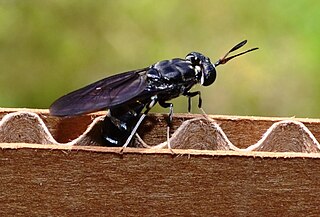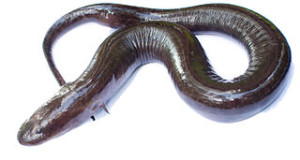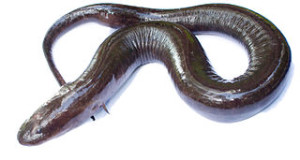Although many salamanders will eagerly gobble-up crickets and mealworms, a diet restricted to these food items usually leads to nutritional disorders and reduced life-spans. This holds true even if supplements are used. A varied diet is essential if you are to have success in keeping salamanders long-term (my 32 year-old Red Salamander, 25 year-old Fire Salamanders and numerous others can attest to this!). Following are some useful tips for those seeking to vary the diets of their terrestrial salamanders. While most newts and aquatic species (Axolotls, Amphiumas) accept dry foods, they too will benefit from invertebrate meals. Please post below for detailed information on individual salamander species. As there is an endless supply of useful live foods for pet salamanders, please also post your ideas and observations.
Earthworms, Red Wigglers, Nightcrawlers (Lumbricus terrestris and relatives)
If you need to rely upon a single food item as a dietary staple for your salamanders, it should be earthworms, not crickets. I cannot recall a single salamander species that does not fare well on an earthworm-rich diet. Earthworms and their relatives reproduce rapidly when kept properly (please see article below) and can be stored for weeks under refrigeration. Their nutritional profile can be improved by a diet of leaf litter, corn meal, fish flakes and calcium powder.
Blackworms (Lumbriculus variegatus)
These nutritious, aquatic earthworm relatives should be confined to a jar lid when offered to terrestrial salamanders, or they will burrow into the substrate and expire. Blackworms will live for weeks in a refrigerator if they are rinsed daily.
Terrestrial Isopods, Sowbugs, Potato Bugs (Order Isopoda)
These crustaceans are a good source of calcium, and likely contain nutrients not found in insects. They are also useful scavengers, consuming dead insects, feces, and shed skins. Isopods may be purchased or collected beneath rocks and leaf litter, and are easy to keep and breed; please see the article linked below for details.
Houseflies (Muscidae) and Phoenix or Calci-worms (Hermetia illucens)
Flightless housefly cultures are commercially available. Although considered more of a frog and lizard food, houseflies should not be overlooked by salamander keepers, as they are soft-bodied and simple to nutrient-load. They are especially valuable for smaller species that are usually restricted to “cricket-only” diets.
Calci-worms, the larvae of Black Soldier Flies, are soft-bodied and contain an ideal calcium: phosphorus profile.
House Crickets (Acheta domestica)
Crickets should be fed a healthful diet prior to being used; cricket pellets, tropical fish flakes, dry milk and reptile calcium powder works well. Oranges, apples or gel cubes should be provided as a water source.
Adult crickets have powerful mouthparts, and their wings and legs are indigestible; use the smallest acceptable size (please see article below).
Orange-Spotted Roaches (Blaptica dubia)
This insect’s soft exoskeleton suits it well as a salamander food. By setting up a breeding colony, you can assure a steady supply of suitably-sized roaches for both small and large salamanders. A diet of fish food flakes, powdered baby food, fruits, vegetables and reptile calcium powder will ensure a nutritious meal for your pets. Please see the article linked below for further information on this and other roaches.
Fruit Flies (Drosophila melanogaster and relatives)
Fruit Flies, including flightless strains, are widely available and can be used for newly-transformed salamanders; cultures are usually supplied with food and instructions.
Red and Confused Flour Beetle Larvae, Tribolium castaneum and T. confusum
Flour Beetle colonies are available commercially; dog biscuits or dried baby food will meet their food and moisture needs. I’ve used their tiny grubs to vary the diets of Red-Backed, Dusky and other small salamanders.
Springtails (Collembolla sp.)
Springtails are minute (as in smaller than fruit flies), primitive insects that can be collected from beneath leaf litter or purchased. They feed upon decaying vegetables and fish flakes, and breed readily.
Wild-Caught Invertebrates
Wild-caught invertebrates can impart important variety to captive diets. Learn to identify stinging and toxic species, and avoid collecting in areas where pesticides are used.
Swinging through tall grass with a net will yield a variety of nutritious aphids, grasshoppers, caterpillars, flies and other “field plankton”. The Zoo Med Bug Napper will help snare moths, crane flies, and beetles. Please post below and see the linked articles for collecting and trapping tips.
Other Insects
Grasshoppers, silkworms, hornworms, praying mantis egg cases (hatchlings are readily taken by Red Efts and other tiny salamanders), butter worms and other invertebrates are commercially available. Even if used only on occasion, they can make a big difference in your pets’ health and longevities.
Waxworms (Galleria mellonella)
These unusual caterpillars reside in beehives. They are shipped in sawdust, which must be removed before use, and should be refrigerated until needed. Due to their high fat content (58%) and thick exoskeleton, they are best used sparingly.
Aquatic Salamanders and Newts
Aquatic salamanders and newts are generally easier to feed than terrestrial species. Most will take Reptomin and similar foods, brine shrimp, daphnia, mosquito larvae, crayfish and minnows, as well as many of the species mentioned above. Please see the articles linked below for more on their care.
Further Reading
 That Reptile Blog – Reptile, Amphibian and Exotic Pet Care and Information
That Reptile Blog – Reptile, Amphibian and Exotic Pet Care and Information







Frank,
I’ve been reading that some people believe that feeding high protein foods like dog food to feeder insects can cause gout in chameleons. Do you think this is a concern for gutloading insects for salamanders? I sometimes use fish feed which is usually quite a bit higher in protein than even dog food. The trouble is I don’t really have a lot of vegetable scraps and chicken feed seems to contain salts and sometimes diatomaceous earth, so I really wasn’t sure if chicken feed would be ideal. I can get worm chow, but only in either 50lbs bags or from people who repackage the feed in their own bags which means I can’t really see the original use by dates.
Hi Kevin,
I’ve used trout chow and tropical fish food as a staple for many feeders (crickets, roaches, sow bugs) for decades at home and in zoos with great results (salamanders and all herp taxa); not sure where the gout info is comming from, but sounds like the all too common speculation we see in so many areas re herp care. Don’t worry about it; it is best to vary diet of feeders with fruits/veg when possible. Commercial cricket foods are another option, but troical fih flakes are ideal as part of the diet for many, including earthworms, sow bugs, crickets, roaches. Please see this article for more info and let me know if you need anything, frank.